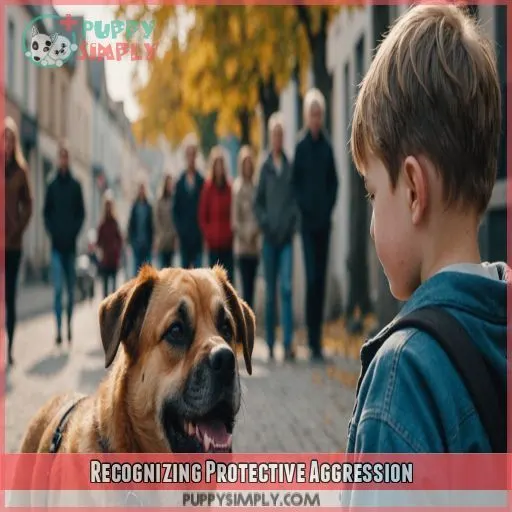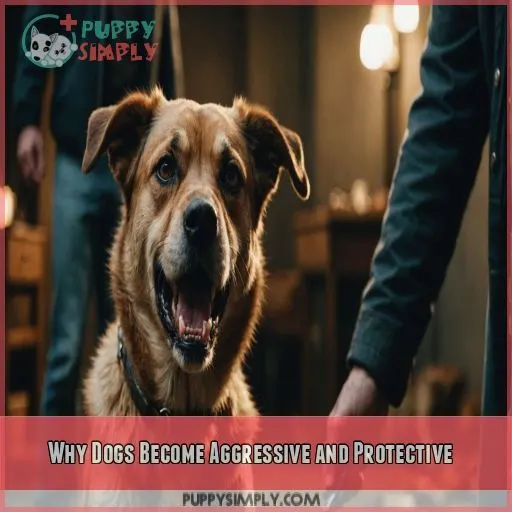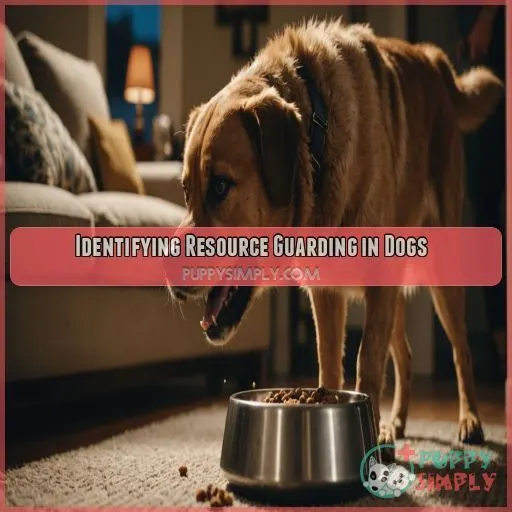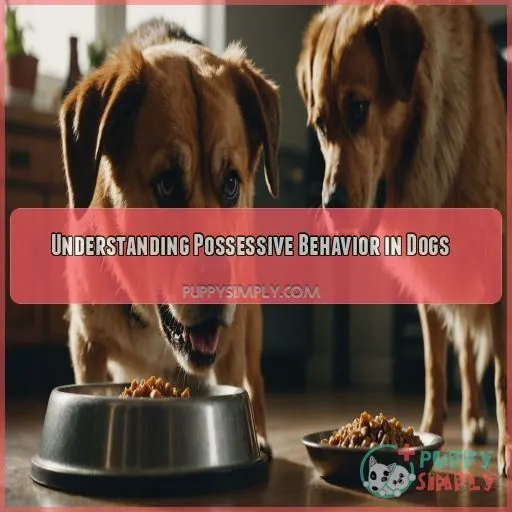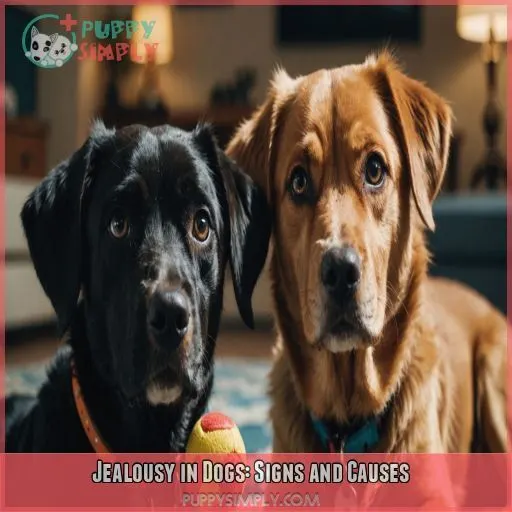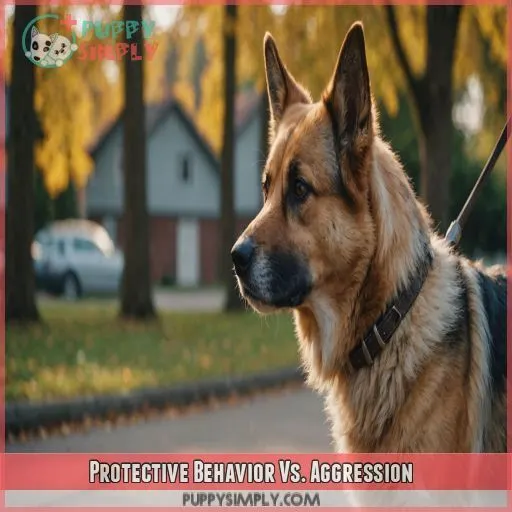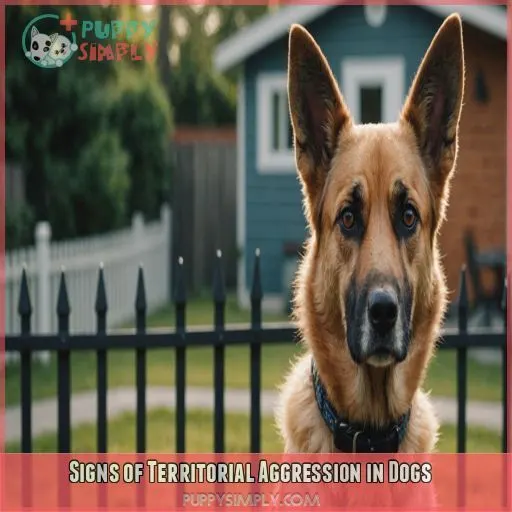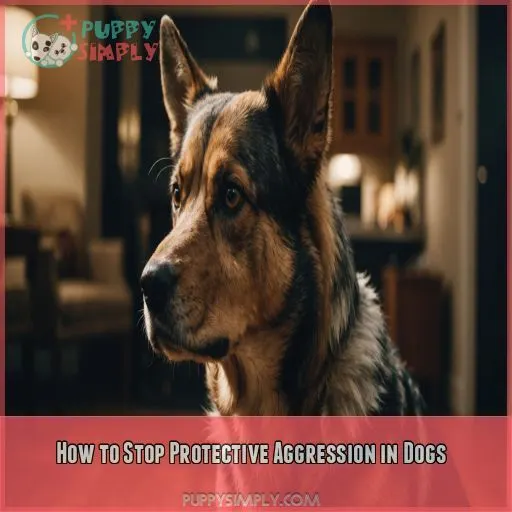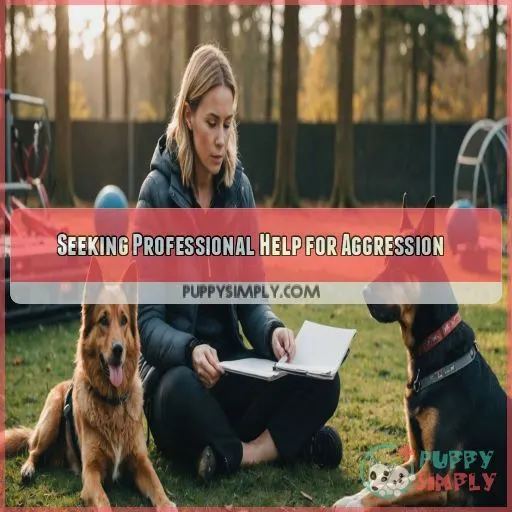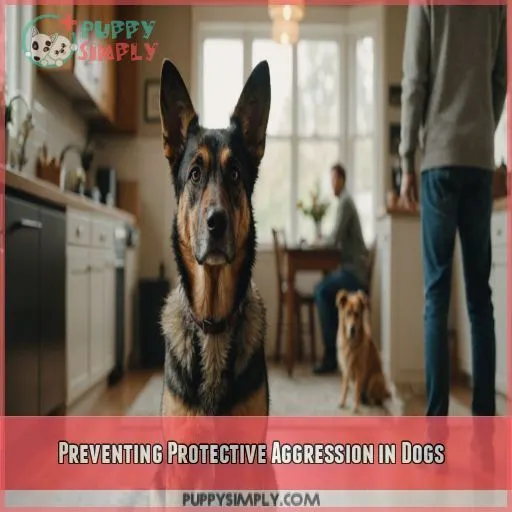This site is supported by our readers. We may earn a commission, at no cost to you, if you purchase through links.
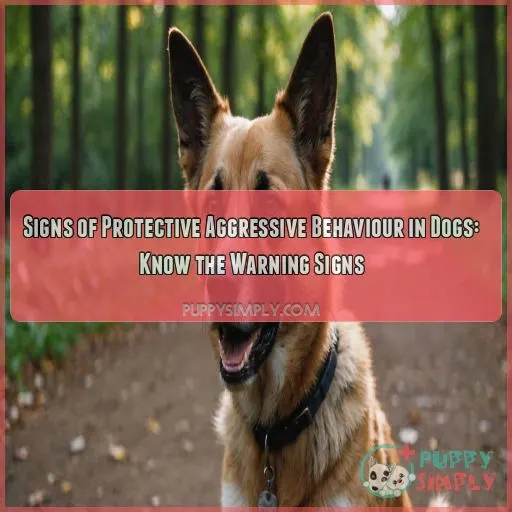 You’re concerned about your furry friend’s behavior, and rightly so!
You’re concerned about your furry friend’s behavior, and rightly so!
Recognizing signs of protective aggressive behavior in dogs is important for a safe and happy household.
So, what are the red flags?
If your dog is barking or growling excessively, overreacting to new situations, or lunging at perceived threats, it’s time to take notice.
Other warning signs include baring teeth, snapping, or biting.
Don’t worry, these behaviors can be addressed with the right approach.
By understanding what triggers your dog’s protective aggression, you can take the first step to a more harmonious home.
But what’s behind this behavior?
Table Of Contents
- Key Takeaways
- Recognizing Protective Aggression
- Why Dogs Become Aggressive and Protective
- Identifying Resource Guarding in Dogs
- Understanding Possessive Behavior in Dogs
- Jealousy in Dogs: Signs and Causes
- Protective Behavior Vs. Aggression
- Signs of Territorial Aggression in Dogs
- How to Stop Protective Aggression in Dogs
- Seeking Professional Help for Aggression
- Preventing Protective Aggression in Dogs
- Frequently Asked Questions (FAQs)
- How do you tell if a dog is aggressive or protective?
- Why is my dog becoming aggressive and protective?
- How do I tell if my dog is guarding me?
- How to stop a dog from protective aggression?
- Can any dog breed exhibit protective aggressive behavior traits?
- How does fear impact a dogs protective aggression tendencies ?
- Are puppies more prone to developing protective aggression ?
- Can multiple dogs in a household exhibit protective aggression?
- Is protective aggression linked to a dogs loyalty instincts ?
- Conclusion
Key Takeaways
- You’ve got a great instinct to recognize your dog’s protective aggression – now take it to the next level by identifying triggers like fear, anxiety, or medical issues, and tackle them head-on with desensitization and counter-conditioning techniques.
- Don’t assume your dog is just being "loyal" or "protective" – there’s often more to the story, like underlying fear or anxiety that’s causing them to become aggressive, so take the time to understand what’s driving their behavior.
- You’re not alone in dealing with a possessive pup – lots of dogs get a little too attached to their favorite toys, food, or even people, but with some training and patience, you can help them learn to share and play nice.
- Your dog’s protective aggression isn’t something to be ashamed of or worried about – it’s actually an opportunity to strengthen your bond, work on training, and create a safer, happier home for everyone (two-legged and four-legged alike!).
Recognizing Protective Aggression
You may have noticed that your furry friend is getting a bit too protective of their territory, food, or even you.
You’re wondering if it’s just normal dog behavior or a sign of something more serious.
Recognizing protective aggression in dogs is important to addressing potential issues before they escalate.
In this article, we’ll explore the warning signs and what you can do to manage them.
Territorial Aggression Signs
When you notice your dog’s behavior changing, pay attention to territorial aggression signs, such as:
- Growling at strangers
- Barking at noises
- Lunging at visitors
- Biting mailmen
- Stiffening up near fences
Resource Guarding Behavior
You’re not alone if your dog growls at people approaching while they’re snuggled up in your lap. Resource guarding occurs when dogs feel frustrated, not protective, in these situations.
| Resource Guarding Triggers | Signs of Resource Guarding | Addressing the Behavior |
|---|---|---|
| Guarding toys, food, space, people | Growling, snapping, showing teeth | Desensitize and counter-condition |
| New people approaching | Stiffening, raising hackles | Reward calm behavior |
| Changes in environment | Freezing, staring | Gradual exposure to triggers |
Possessive Behavior Indicators
You’re likely familiar with possessive behavior in dogs – they guard valuable resources like toys, food bowls, and even their owners. Here are 4 common indicators:
- Toy guarding: Growling or snapping when you approach their favorite toy.
- Food bowl protection: Resource guarding their food, even when the bowl is empty.
- Owner attachment: Becoming overly attached to one person, showing aggression toward others.
- Space dominance: Claiming a specific area, like a bed, and defending it from others.
Jealousy in Dogs
Now that you’re familiar with possessive behavior, let’s talk about jealousy in dogs – it’s like they’re saying, "Hey, that’s my person, back off!" Recognize the signs to address it.
Why Dogs Become Aggressive and Protective
You’re probably wondering why your furry friend is suddenly growling at strangers or resource guarding their favorite treats. It all boils down to a mix of fear and anxiety triggers, lack of socialization and training, medical issues, and breed characteristics that can make your dog feel the need to protect themselves, you, or their territory.
Fear and Anxiety Triggers
You want to know what triggers fear and anxiety in dogs? Here are some common culprits:
- Loud noises that startle them
- Unfamiliar people or environments that make them uneasy
- Separation anxiety when you leave them alone
- Changes in routine that throw them off balance
Lack of Socialization and Training
Your pup’s lack of socialization and training can fuel protective aggression. Early puppy socialization and positive reinforcement training can help curb fear and anxiety triggers, leading to a more relaxed dog.
Medical Issues and Pain
Your furry friend’s sudden growls might be more than just a bad mood – underlying medical issues like arthritis or medication side effects can trigger a protective nature.
Breed Characteristics and Instincts
Some breeds, like guard dogs, have instinctual behavior to protect their pack, while herding breeds may exhibit strong prey drive or guarding instincts due to their original roles.
Identifying Resource Guarding in Dogs
As you explore canine behavior, you need to recognize the subtle signs of resource guarding in your dog – a behavior that can quickly escalate into full-blown aggression. By learning to identify the warning signs, you’ll be better equipped to address this protective behavior and prevent it from becoming a serious issue.
Signs of Resource Guarding Behavior
In the context of resource guarding, your dog’s behavior can be downright scary. Here are some signs to watch out for:
- Growling or snapping when you approach their food bowl
- Stiffening or freezing when you try to take a toy
- Raising their hackles or showing their teeth
- Muzzle punching or biting
- Blocking access to their favorite things
Distinguishing Resource Guarding From Possessiveness
When your dog growls at you for approaching their food or toys, it’s likely resource guarding. But if they’re protective of you, it’s possessiveness. Look for canine behavior cues like a tense posture, raised hackles, or a stiff tail. Distinguish between resource guarding signs and possessiveness indicators to address the underlying issue effectively.
Understanding Possessive Behavior in Dogs
You’re probably familiar with the sight of your dog growling or snapping when you try to take away their favorite toy or treat – that’s possessive behavior in action. Understanding what drives this behavior and learning to recognize the signs can help you address it before it escalates into full-blown aggression.
Causes of Possessive Behavior
You’ve likely encountered a dog that just wouldn’t share its favorite toy. Possessive behavior in dogs often stems from insecurity, lack of trust, and a fear of loss, which can be rooted in past experiences or a desire for dominance.
Signs of Possessive Behavior
Frequently, you’ll notice your dog displaying possessive behavior when they growl, snap, or whine when you approach their food bowl or favorite toy. They may also become protective of their sleeping area or owner, seeing them as their own.
Differences From Resource Guarding
You need to understand the differences between possessive behavior and resource guarding in dogs. Here are key distinctions:
- Possessive behavior is about control and dominance
- Resource guarding is about protecting valuable resources
- Possessive behavior can be owner-directed
- Resource guarding is often triggered by approaching people or animals
- Training methods vary for each behavior
Jealousy in Dogs: Signs and Causes
If you’ve noticed your dog trying to squeeze between you and another person or pet, or getting a little too defensive when someone approaches, it may be exhibiting jealous behavior. Learning to recognize the signs and triggers of jealousy in dogs can help you manage their behavior and build a stronger, more loving relationship with your furry friend.
Recognizing Jealous Behavior
Now that you’ve got a handle on possessive behavior, let’s talk jealousy. Recognizing jealous behavior in dogs can be tricky, but look for signs like pushing other pets away, growling, or trying to squeeze between you and others.
Triggers for Jealousy in Dogs
You’ve recognized the jealous behavior in your dog, now it’s time to identify the triggers. A new pet, attention shift, food rivalry, owner interaction, or toy competition can spark jealousy in dogs. Know these triggers to address the root cause.
Managing Jealousy in Dogs
Now that you’re aware of the triggers for jealousy in dogs, let’s tackle managing it. To prevent jealousy, train your dog to associate attention from others with positive experiences, and reward calm behavior, making them feel secure and loved.
Protective Behavior Vs. Aggression
As you navigate the complex world of canine behavior, you need to distinguish between protective behavior and aggression in your dog. By understanding the warning signs and characteristics of each, you can take proactive steps to address potential issues and foster a stronger, more loving relationship with your furry friend (Source).
Characteristics of Protective Behavior
As you navigate your dog’s behavior, understanding protective instincts is key. A protective dog is alert, focused, and vocal, using body language to defend its pack. This natural behavior is driven by instinct, not aggression, and can be channeled positively.
Distinguishing Protective Behavior From Aggression
When your dog growls at strangers, it’s important to distinguish between protective behavior and aggression. Look for body language cues, consider the situational context, and assess the threat to determine whether your dog is being protective or aggressive.
Breed Differences in Protective Behavior
When it comes to protective behavior, breed differences play a significant role. Herding breeds, like German Shepherds, may exhibit strong guarding instincts due to their working dog history. Consider the following breed-specific traits:
- Herding breeds: Strong work ethic and loyalty
- Guarding breeds: Naturally protective, but may require more socialization
- Companion breeds: Friendly, outgoing, but may be wary of strangers
Signs of Territorial Aggression in Dogs
You know your dog is protective of you and your home, but how can you tell if their behavior is crossing the line into territorial aggression? If your dog is growling, barking, or even biting when strangers approach your home or yard, it’s time to take a closer look at the warning signs of territorial aggression (Source).
Warning Signs of Territorial Aggression
You’re probably wondering what warning signs to look out for in your furry friend. Territorial aggression can manifest in various ways, including:
| Mild Warning Signs | Moderate Warning Signs | Severe Warning Signs |
|---|---|---|
| Growling, barking | Lunging, snapping | Biting, chasing |
| Raising hackles | Showing teeth | Attacking people/animals |
| Stiffening posture | Blocking access | Becoming aggressive |
| Avoiding eye contact | Increasing vocalization | Losing control completely |
Keep an eye out for these signs, and you’ll be better equipped to address territorial aggression in your dog.
Triggers for Territorial Aggression
Now that you know the warning signs of territorial aggression, let’s explore what triggers it. Think new people, loud noises, unfamiliar objects, changes in routine, or even just entering or leaving home – all these can set your dog off.
Managing Territorial Aggression
Now that you know what triggers territorial aggression in your dog, it’s time to take action. Manage territorial aggression by creating safe spaces, using calming treats, and practicing positive reinforcement training, like leash training, to help your dog feel secure.
How to Stop Protective Aggression in Dogs
You’ve identified the warning signs of protective aggression in your dog – now it’s time to take action to stop it. By using desensitization and counter-conditioning techniques, training exercises, and managing triggers and stimuli, you can help your dog feel more secure and reduce aggressive behavior.
Desensitization and Counter-Conditioning Techniques
You can use desensitization and counter-conditioning techniques to help your dog overcome protective aggression. Here are some training tools to get you started:
- Positive reinforcement treats
- Gradual exposure to triggers
- Calming aids like pheromone diffusers
- Desensitization exercises
- Counter-conditioning games
Training Exercises for Reducing Aggression
Now that you’ve started desensitization and counter-conditioning, it’s time to get moving with training exercises that reduce aggression. Leash training is key, paired with a reward system that encourages positive reinforcement – think treats and praise!
Managing Triggers and Stimuli
Now that you’ve learned some training exercises to reduce aggression, it’s time to tackle the tough stuff: managing triggers and stimuli. Identify what sets your dog off, and use desensitization methods and counter-conditioning strategies to help them chill out.
Seeking Professional Help for Aggression
If your dog is showing signs of protective aggression, it’s time to seek professional help.
Don’t worry, it’s not a failure on your part, but rather a brave step toward creating a safer, happier relationship with your furry friend.
Consulting a professional trainer or behaviorist can help you identify underlying causes and develop a customized plan to address the aggression.
This will allow you to enjoy a more relaxed, stress-free life with your dog.
When to Consult a Professional
If you’re struggling to manage your dog’s aggression, don’t hesitate to seek professional help. Escalating aggression, biting incidents, or safety concerns can cause significant anxiety – a professional can help you develop a customized plan to address these issues.
Working With a Trainer or Behaviorist
Now that you know when to seek help, let’s find the right expert! When working with a trainer or behaviorist, consider:
- Experience: Look for trainers with experience handling aggressive dogs.
- Qualifications: Check for certifications like CPDT or KPA.
- Methods: Opt for positive, reward-based training methods for a safer, more effective approach.
Addressing Underlying Medical Issues
Now that you’re working with a trainer or behaviorist, it’s time to rule out any underlying medical issues that could be fueling your dog’s aggression – think thyroid issues, pain management, or even Cushing’s disease – with a thorough vet check.
Preventing Protective Aggression in Dogs
You can play a significant role in preventing protective aggression in your dog by socializing them well and using positive reinforcement training techniques. By managing their environment, being aware of triggers, and building a strong bond with your dog, you can reduce the likelihood of them developing aggressive behavior (Source).
Socialization and Training Techniques
Now that you know when to seek professional help for aggression, let’s focus on prevention. To prevent protective aggression in dogs, use positive reinforcement training techniques, including:
- Puppy socialization to help them interact with strangers and other animals
- Early training with obedience commands to establish clear boundaries
- Behavior modification exercises to reward calm behavior
Managing Environment and Triggers
To manage environment and triggers, identify what sets your dog off. Create safe spaces and use leash and crate training to minimize interactions. Be mindful of routine changes, like new visitors or loud noises, and plan accordingly.
| Trigger Identification | Action Plan |
|---|---|
| New Visitors | Leash training, calm introductions |
| Loud Noises | White noise, calm spaces |
| Changes in Routine | Gradual adjustments, consistent scheduling |
| Resource Guarding | Desensitization, counter-conditioning |
| Territorial Aggression | Crate training, safe zones |
Building a Strong Bond With Your Dog
Regularly spend quality time with your dog, incorporating daily walks, playtime, and affectionate touch. Positive reinforcement and consistent training will help strengthen your bond, reducing the likelihood of protective aggression and fostering a more confident, calm companion.
Frequently Asked Questions (FAQs)
How do you tell if a dog is aggressive or protective?
To tell if a dog is aggressive or protective, look for signs like growling, snapping, or biting – if it’s fear-based, it’s likely aggression, but if it’s calm and alert, it might be protective behavior .
Why is my dog becoming aggressive and protective?
Old habits die hard," and it’s possible your dog is becoming aggressive and protective due to lack of socialization, fear, or anxiety; try retraining them with positive reinforcement and desensitization techniques to address the underlying issues.
How do I tell if my dog is guarding me?
Here’s how to tell if your dog is guarding you: Pay attention to body language – if they stiffen, growl, or nudge others away when you’re interacting with someone, it’s likely resource guarding, and they’re feeling protective of you.
How to stop a dog from protective aggression?
Want to curb your dog’s protective aggression? Start by teaching them to associate new people with positive experiences. Reward calm behavior, desensitize them to triggers, and seek professional help if needed – your dog (and guests) will thank you!
Can any dog breed exhibit protective aggressive behavior traits?
Don’t assume only guarding breeds exhibit protective aggression! Any dog, regardless of breed or size, can develop protective aggressive behavior traits if they feel their family or territory is being threatened, so stay vigilant and socialize them well.
How does fear impact a dogs protective aggression tendencies ?
When your dog’s fear kicks in, their protective aggression tendencies can escalate, making them more likely to growl, snap, or bite. Fear fuels their defensiveness, causing them to become more territorial and possessive .
Are puppies more prone to developing protective aggression ?
Raising a puppy is like holding a lump of clay – it’s moldable, but it can also crack under pressure. You’ve got a clean slate, so socialize your puppy extensively to prevent protective aggression from taking root.
Can multiple dogs in a household exhibit protective aggression?
If you have multiple dogs at home, they can all exhibit protective aggression, especially if they’re not socialized properly or feel their resources are being threatened, so it’s essential to train and manage them individually.
Is protective aggression linked to a dogs loyalty instincts ?
When you notice your dog exhibiting protective aggression, it’s likely linked to their loyalty instincts. They’re trying to safeguard you and their territory from perceived threats . This behavior is rooted in their natural pack mentality .
Conclusion
Ironically, our furry friends’ attempts to protect us can sometimes put us in harm’s way.
Recognizing the signs of protective aggressive behaviour in dogs is essential to preventing accidents and fostering a harmonious home.
By understanding what triggers your dog’s protective aggression, you can take steps to address it.
Don’t let fear and anxiety get the best of your dog – with patience, training, and love, you can help them feel secure without becoming overly defensive.

